10 Things to Know About California High-Speed Rail
Ten Things to Know About California High-Speed Rail
A general rule of thumb: the more someone knows about California High-Speed Rail, the more likely that person wants to pull the plug on it.
1. In November 2008, 53% of California voters approved Proposition 1A, which hinted at a $45 billion statewide high-speed train system linking Southern California counties, the Sacramento/San Joaquin Valley, and the San Francisco Bay Area. Now it’s a $64 billion high-speed rail line to connect San Jose and Palmdale while tacking on some improvements or expansions to existing commuter rail infrastructure to reach San Francisco and Los Angeles. The lines from Los Angeles to San Diego and to Sacramento are a pipe-dream. Some would call Proposition 1A a Bait-and-Switch.
2. California High-Speed Rail was never intended to zip alongside Interstate 5 between San Francisco and Los Angeles, contrary to what many voters assumed. It’s a Local, including stops in Merced, Fresno, Bakersfield, Palmdale, and maybe Hanford. Cities and counties in the Central Valley demand these stations to bring jobs and economic prosperity. Even more, cities and counties covet the high-speed rail’s “Heavy Maintenance Facility,” despite the greenhouse gas emissions it will produce.
3. Claims made in Proposition 1A for an “efficient 220 MPH transportation system” to go non-stop from San Francisco to Los Angeles in 2 hours, 40 minutes were foolhardy. The train will have to slow down south of San Francisco (on the Peninsula), over the Pacheco Pass (the passage for Highway 152), and through the Tehachapi Mountains between Bakersfield and Los Angeles. Besides, how many trains in practice won’t be making several stops along the way?
4. Proposition 1A claimed that the high-speed rail would get “federal, private, local, and state monies.” In fact, state law requires the California High Speed Rail Authority to “obtain other private and public funds.” But the federal government is dealing with a $19.2 trillion debt, and the FY 2015 budget deficit was $438 billion. In addition, there are no serious potential private investors: corporations want to GET money through contracts with California High-Speed Rail, not GIVE money to it as an “investor.”
5. Did anyone read the fine print of Proposition 1A? The figure of $9.95 billion in the title of Prop 1A was NOT the cost of the high-speed rail. That was the amount voters authorized the state to BORROW to get the project underway by selling bonds to investors. That borrowed money will have to be paid back, with interest! The real cost of Proposition 1A – with interest – was cited at $19.4 billion, and “the total cost to develop and construct the entire high-speed train system would be about $45 billion.” (That figure was atrociously wrong.)
6. Where will the state get money to pay interest on the bonds to investors? No one really knows right now. According to Proposition 1A, interest payments may “average about $647 million per year.” Less for schools, colleges, state services and water projects; more for Wall Street bond investors.
7. Unions have a monopoly on construction of the high-speed rail because of a “Project Labor Agreement” disguised under the nice-sounding euphemism “Community Benefit Agreement.” This will be the most expensive construction project in human history, and it will attract union workers from all over the country (and probably other countries) to the Central Valley. (Union health insurance trusts should plan for many cases of the disease “Valley Fever.”)
8. That same “Community Benefit Agreement” includes provisions encouraging contractors to employ people with such challenges as these: (1) being homeless; (2) being a custodial single parent; (3) receiving public assistance; (4) lacking a GED or high school diploma; (5) having a criminal record or other involvement with the criminal justice system; (6) suffering from chronic unemployment; (7) emancipated from the foster care system. The desire to help the disadvantaged is noble, but it is appropriate for a high-speed rail project?
9. In November 2008, 78.4% of San Francisco voters approved Proposition 1A. It won statewide with 53% of the vote. Why isn’t that city contributing a disproportionate amount to a project that won’t serve most of the state? Proposition 1A told voters there would be municipal investment – where is it?
10. The claim that passengers will one day conveniently buy a ticket and then hop aboard the train without time-consuming security lines is utter nonsense. The California High-Speed Rail Authority will need to adopt comprehensive passenger security procedures and provide costly protection for the rail itself in urban, suburban, and rural environments. Future governors will surely place a priority on continually evaluating vulnerabilities and threats, and the state legislature will have endless challenges getting funding for programs to protect the high-speed rail system from terrorist attacks, pranksters, fools, and suicides. Expect these programs to include unionized government employees and expensive technology, including drones.

